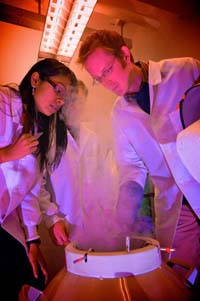6 A&S Physicists Awarded Breakthrough Prize
Our universe is dominated by matter and contains hardly any antimatter, a notion which still perplexes top scientists researching at CERN’s Large Hadron Collider. The Big Bang created equal amounts of matter and antimatter, but now nearly everything—solid, liquid, gas or plasma—is…


 Most cell biomechanics research has examined cell behavior on unchanging, flat surfaces. “Living cells are remarkably complex, dynamic and versatile systems, but the material substrates currently used to culture them are not,” says Henderson (at right in photo). “What motivated our work was the need for cell culture technologies that would allow dynamic control of cell-material interactions. We wanted to give a powerful new tool to biologists and bioengineers.”
Most cell biomechanics research has examined cell behavior on unchanging, flat surfaces. “Living cells are remarkably complex, dynamic and versatile systems, but the material substrates currently used to culture them are not,” says Henderson (at right in photo). “What motivated our work was the need for cell culture technologies that would allow dynamic control of cell-material interactions. We wanted to give a powerful new tool to biologists and bioengineers.”